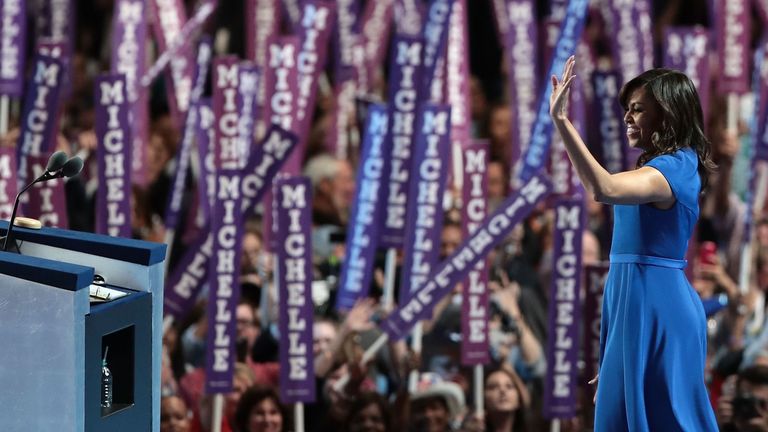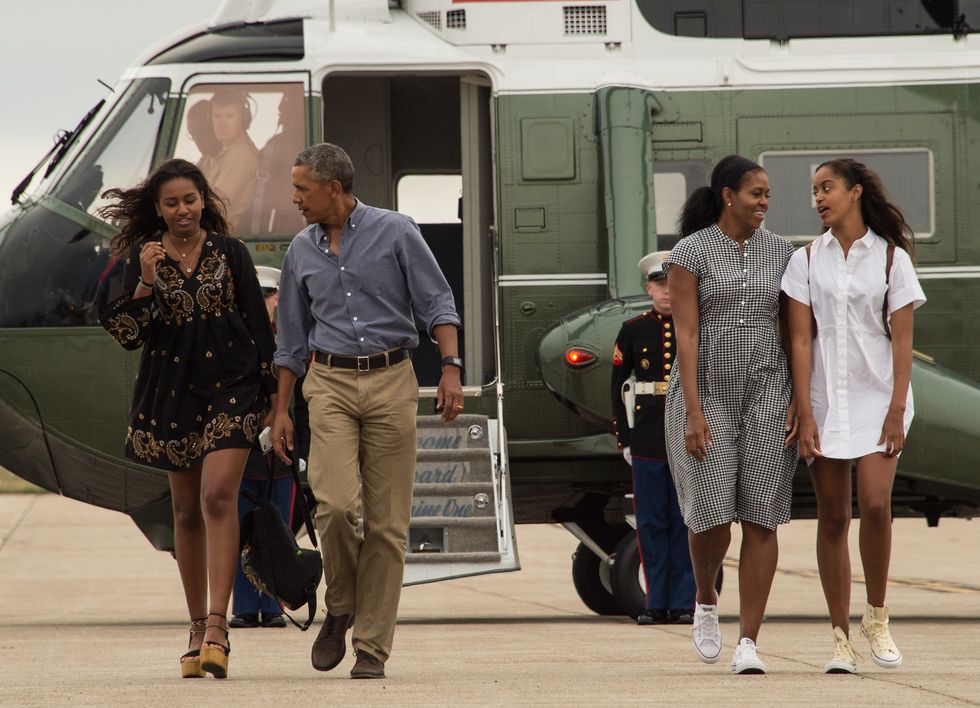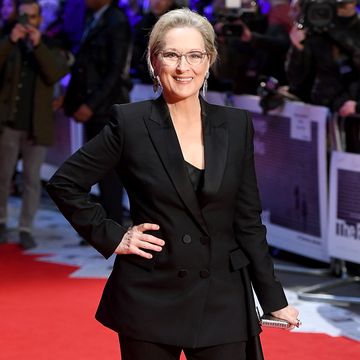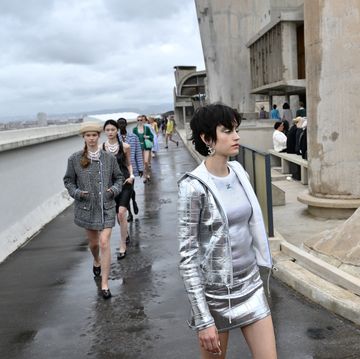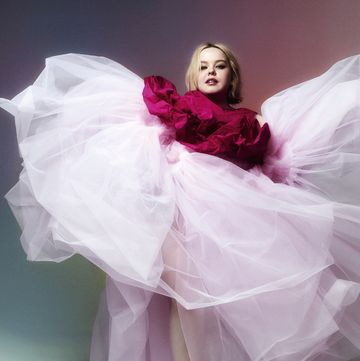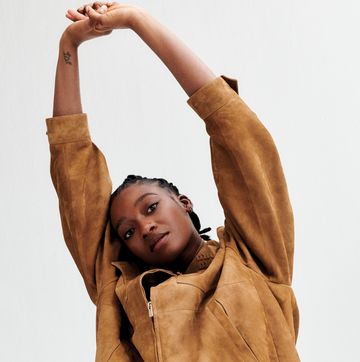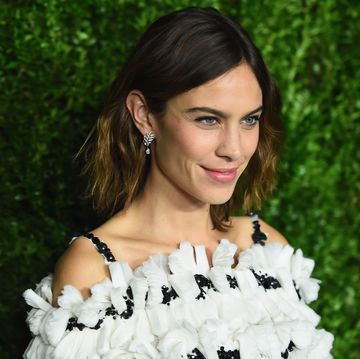Michelle Obama's final year as First Lady was also a stellar year for women of colour. The world watched as they made headlines and the history books as Kamala Harris did when she became only the second African-American woman senator in U.S. history and Ava DuVernay the first black woman to direct a big budget live action movie. And then there was Beyoncé and Solange Knowles releasing what was arguably the two most important assertions of black feminism in the history of pop culture. And Chimamanda Ngozi Adichie using her Boots campaign to make an intellectual statement on femininity. And the young girls of Pretoria High in South Africa protesting draconian school bans on their natural hair. That's no coincidence.
Because as much as Barack Obama introduced the world to the bold, once unimaginable reality that, yes, a black child can grow up to be President, Michelle Obama has driven home an equally powerful message: the normalisation of women of colour as educated bosses, global leaders, profitable business owners, powerful activists and more.
To be clear, normality is in the eye of the beholder. And one's default setting is usually what you are. The idea of a university-educated, self-actualised, professional black, latina or Asian woman winning at life has always been normal to me because I've grown up with examples of this in my life. With the exception of a Claire Huxtable here or an Oprah Winfrey there, I might not have always seen these women represented on television or in magazines when I was growing up, but I knew they were out there, even if in relatively fewer numbers than their white counterparts.
Of course we are more than soul singers, single mothers, or side-eye slinging sidekicks saying Bye Felicia. But by the looks of what I saw in the media, the rest of the world didn't seem to know this.
And then came Michelle.
My first memory of her was at a political fundraiser I went to in New York in 2007. She wasn't in the room, and yet she was. Her husband, this bright new star on the presidential campaign trail was on stage talking about his wife back home in Chicago, about her career as a lawyer and how she inspired him personally and professionally.
This is a woman who graduated from Princeton University and Harvard Law School and for a time, out earned her husband's Senator salary through her own well-paid role as a Vice President at the University of Chicago Hospitals.
But a year later, Michelle would find herself being pinned to an old, reductive single narrative: the angry black woman. The New Yorker magazine even went as far as to satirise this by placing Michelle and Barack on the cover, Michelle illustrated with an AK-47 and an Afro (because, all black women with Fros are angry?!) giving Barack, dressed in traditional Muslim garb, a fist bump. Never mind that she wears her hair blown out or that the fist bump is historically a gesture of love, not anger. To masses of people, this is how black womanhood looked. And while there is plenty for a woman of any race to get angry about right now, the stereotype simply does not ring true.
When the Obamas moved into the White House eight years ago they brought with them the most diverse administration the country has ever seen, with women and minorities holding the most top positions in history. The Washington Post credited the President with 'fundamentally changing the face of the federal workforce.' And among those faces, were prominent black women: Senior Advisor, Valerie Jarrett, Ambassador to the United Nations Susan Rice and Head of Domestic Policy Council Melody Barnes, to name a few. The following year, he appointed the Supreme Court's third woman and only Latina justice, Sonia Sotomayor.
According to research conducted at the University of California at Berkeley, Obama placed women and minorities in 53.5 percent of government appointed positions. 'So yes, African Americans, women, Latinos, Native Americans, people with disabilities, the LGBT community. He wanted to make sure that everybody had an opportunity to serve in his administration and that its diversity reflected the diversity of our country,' Jarrett explained in an interview with The Washington Post.
But in doing so, the Obamas also showed a more diverse, and more accurate, picture of women of colour, correcting the stereotypes with the kind of intelligent, successful women who might have seemed foreign to some, but were normal to women like me.
When the Obamas moved into The White House at the start of 2009, I had recently moved to London, a city with great diversity and yet to this day shockingly few examples of it in government, on the screen and other positions of influence. But Michelle Obama had an impact here too: appearing in the free dailies being handed out on my commute home hugging schoolgirls at Oxford one day and then welcoming a range of kids to The White House as part of her Let's Move campaign the next. When she spoke to a stadium full of college graduates at Tuskegee University about the realities of being a black woman, it spread just as far and wide globally as her YouTube clips dancing with Beyoncé or carpool karoakeing with Missy Elliott.
In 2008, the top television shows featuring black people were The Wire (drugs, poverty and disenfranchised youth in Baltimore, Maryland), 30 Rock (identity politics courtesy of comedic sidekick Tracy Morgan), and True Blood (sassy, sidekick vampire-hating black girl with attitude.)
Eight years later at the end of the Obama era the lineup looks very different with programs that show a wider breadth of experience. There are alpha bosses such as Olivia Pope of Scandal and Annalise Keating of How to Get Away With Murder (two characters written by a black woman, Shonda Rhimes), refreshingly ordinary millenials like Issa Rae's Issa Dee and best friend Molly in the HBO show Insecure and frustrated virgins like Michaela Coel's Tracey in her critically acclaimed comedy Chewing Gum, to name just a few. These are all shows created by people of colour, all shows with healthy ratings, awards nods, and season renewals.
Meanwhile, on the big screen, Hidden Figures, a movie about three pioneering black women NASA mathematicians working in Jim Crow-era Virginia, outperformed Rogue One: A Star Wars Story at the American box office.
The gains happened in the corporate world as well. The American media conglomerate ABC appointed Channing Dungey the first black woman to head a broadcast network. And Apple and iTunes head of global consumer marketing, Bozoma Saint John, reached tech world stardom when she became the first black woman to break up the usual lineup of white men at an Apple keynote.
Even as racial tensions, divisions and and violence reached new highs, and as a long list of black women including Rekia Boyd and Sandra Bland became tragic hashtags, a wave of woke, unapologetically black women rose to the fore, using their large social media platforms to promote justice and equal rights, women like Tracee Ellis Ross, Amandla Stenberg, Yara Shahidi, Adwoa Aboah, Luvvie Ajayi, and more.
And while much of the above can be attributed to the general cultural tides of change, it's hard to imagine any of it happening without Michelle Obama. Her impact promises to last longer than her eight years as First Lady because there's a generation of young girls who have only ever known the Obamas as First Family. They aren't old enough to watch Olivia Pope or Issa Dee, but they have spent their formative years getting to know Michelle, Malia and Sasha. And for that generation, the Obamas are their normal.
That's a powerful thought. Because the more the world becomes used to the idea of seeing diversity in positions of power — from a black First Lady to a Latina Supreme Court justice — the more organically diversity will grow.
Kenya Hunt is the Editor-in-Chief of ELLE UK. Her career spans working for some of the world's most influential women’s titles on both sides of the Atlantic from her post-graduate days as an Assistant Editor at the seminal magazine, Jane, to her time as Deputy Editor of Grazia UK and ELLE UK. As the founder of R.O.O.M. Mentoring, she advocates for greater diversity within the fashion industry by providing a supportive network for some of the many talented aspiring designers, journalists and image makers of colour London has to offer. In 2021, she was recognised by The British Fashion Council for her work and given a Global Leader Of Change Award at its annual Fashion Awards. An American based in London, she lives south of the river with her husband and two sons. Her critically-acclaimed book, Girl: Essays on Black Womanhood (HarperCollins/HQ), is out now.
